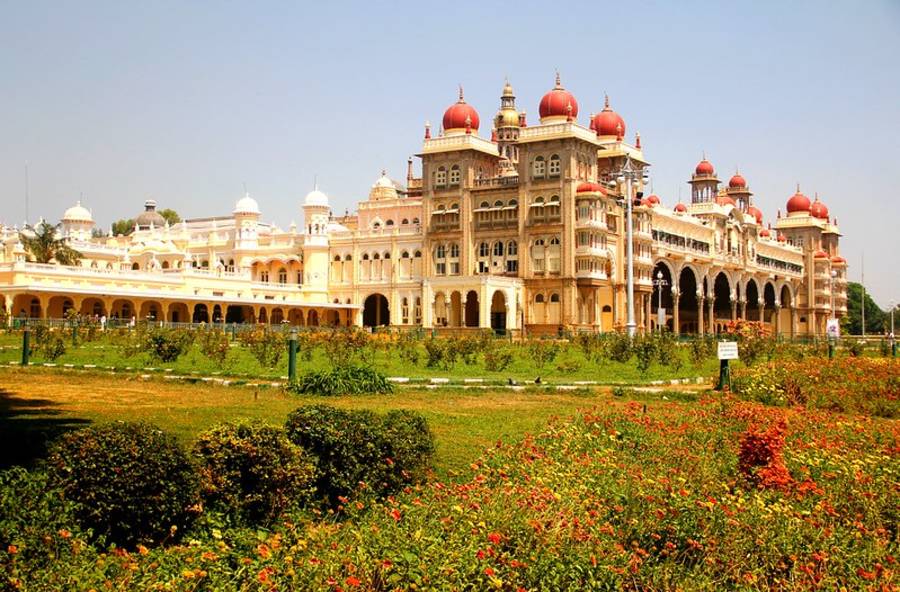Maharaja Palace
The Maharaja Palace is a beautiful palace located inside the Jaisalmer Fort in the city of Jaisalmer, Rajasthan, India. The palace was built by Maharawal Mool Raj II in the late 19th century and is known for its intricate architecture and stunning beauty.
The palace is a fusion of Rajput and Islamic architectural styles and features beautifully carved stone screens, ornate balconies, and intricate jharokhas (overhanging enclosed balconies). It also has a beautiful collection of artifacts and paintings that reflect the rich history and culture of Jaisalmer.
The Jaisalmer Fort, also known as Sonar Quila, is a UNESCO World Heritage Site and is one of the largest forts in the world. The fort was built in 1156 AD by Rajput ruler Jaisal and is famous for its golden sandstone walls that give it a golden hue in the sunlight.
The fort is home to many beautiful palaces, temples, and havelis (traditional Indian mansions) that are a testament to the rich history and culture of Jaisalmer. The fort also offers stunning views of the city and the Thar Desert.
Visitors to Jaisalmer should not miss the opportunity to visit the Maharaja Palace and the Jaisalmer Fort to experience the beauty and history of this ancient city.
History
Jaisalmer, the city in which the Maharaja Palace and Jaisalmer Fort are located, has a rich and fascinating history. The city was founded by Rawal Jaisal, a Rajput ruler, in 1156 AD. Jaisalmer was strategically located on the trade route that connected India with Central Asia, making it an important center of trade and commerce.
Over the centuries, Jaisalmer was ruled by different Rajput rulers, including the Bhati Rajputs, who made the city their capital. The city was known for its thriving trade in spices, textiles, and precious stones, which attracted traders and merchants from all over India and beyond.
During the Mughal period, Jaisalmer came under the influence of the Mughal Empire, but the Rajput rulers managed to maintain their autonomy and continued to rule the city. Later, during the British colonial period, Jaisalmer became part of the princely state of Jaisalmer, which was a vassal state of the British Raj.
The Maharaja Palace inside Jaisalmer Fort was built in the late 19th century by Maharawal Mool Raj II, who was a patron of the arts and architecture. The palace was built to showcase the wealth and power of the Rajput rulers and to provide a luxurious residence for the Maharaja and his family.
Today, Jaisalmer is a popular tourist destination that attracts visitors from all over the world who come to explore its rich history, culture, and architecture. The Maharaja Palace and Jaisalmer Fort are among the top tourist attractions in the city, offering visitors a glimpse into the grandeur and beauty of the Rajput era.
Architecture
The architecture of the Maharaja Palace and Jaisalmer Fort in Jaisalmer is a blend of Rajput and Islamic styles. The buildings are constructed from yellow sandstone, which gives them a warm and golden glow in the sunlight.
The Maharaja Palace is a beautiful example of Rajput architecture. The palace has several levels and is adorned with intricate carvings and jharokhas (overhanging enclosed balconies). The palace has a grand entrance that leads into a courtyard, which is surrounded by beautiful buildings that house the various sections of the palace. The palace also has a beautiful collection of artifacts and paintings that reflect the rich history and culture of Jaisalmer.
The Jaisalmer Fort is also a marvel of architecture. The fort is one of the largest forts in the world and is made entirely of sandstone. The fort walls are up to 30 feet high and 70 feet wide, and they are punctuated by several gates and bastions. Inside the fort, visitors can find several beautiful havelis (traditional Indian mansions), temples, and palaces. These buildings feature intricate carvings, jharokhas, and beautiful courtyards.
One of the unique architectural features of the Jaisalmer Fort is its underground water storage system. The fort was built in the desert, and water was a scarce resource. The fort has several tanks and wells that were used to collect and store rainwater, which was then used for drinking and other purposes.
Overall, the architecture of the Maharaja Palace and Jaisalmer Fort is a testament to the skill and creativity of the Rajput architects and builders. The buildings are not only beautiful, but they are also functional and designed to withstand the harsh desert climate of the region.
Entry Fee
As of my knowledge cutoff date of September 2021, the entry fees for visiting the Maharaja Palace and Jaisalmer Fort were as follows:
- Maharaja Palace: The entry fee for visiting the Maharaja Palace was Rs. 250 for Indian citizens and Rs. 500 for foreign tourists. The palace is open to visitors from 9:00 am to 5:00 pm.
- Jaisalmer Fort: The entry fee for visiting Jaisalmer Fort was Rs. 50 for Indian citizens and Rs. 250 for foreign tourists. The fort is open to visitors from 9:00 am to 6:00 pm.
Please note that the entry fees may have changed since my knowledge cutoff date, and it is always a good idea to check the latest information before visiting these attractions. Additionally, there may be additional charges for services such as photography, videography, or audio guides.
Timings
As of my knowledge cutoff date of September 2021, the timings for visiting the Maharaja Palace and Jaisalmer Fort were as follows:
- Maharaja Palace: The palace is open to visitors from 9:00 am to 5:00 pm.
- Jaisalmer Fort: The fort is open to visitors from 9:00 am to 6:00 pm.
Please note that the timings may have changed since my knowledge cutoff date, and it is always a good idea to check the latest information before visiting these attractions. Also, it’s advisable to reach early as both places are popular tourist attractions and can get crowded during peak hours.
Things to See
There are several things to see and explore at the Maharaja Palace and Jaisalmer Fort. Here are some of the top attractions:
Maharaja Palace Museum:
The palace has been converted into a museum that showcases the art, culture, and history of Jaisalmer. Visitors can see a variety of artifacts, including weapons, paintings, textiles, and royal costumes. The museum also has a beautiful collection of antique furniture and other items used by the royal family.
Jain Temples:
Jaisalmer Fort is home to several beautiful Jain temples, including the famous Jain Temples of Jaisalmer. These temples are known for their intricate carvings and beautiful architecture. Visitors can explore these temples and learn about the rich Jain history and traditions.
Raj Mahal:
The Raj Mahal is a beautiful palace inside Jaisalmer Fort that was once the residence of the Rajput rulers. The palace features beautiful courtyards, intricate carvings, and a collection of antique furniture and paintings.
Havelis:
Jaisalmer is known for its beautiful havelis, which are traditional Indian mansions. The city has several havelis that are open to visitors, including Patwon ki Haveli, Nathmal ki Haveli, and Salim Singh ki Haveli. These havelis are known for their beautiful architecture, intricate carvings, and historical significance.
Sunset Point:
Jaisalmer Fort is located on a hill, and it offers a beautiful panoramic view of the city. Visitors can enjoy a stunning sunset view from the fort’s ramparts and take in the breathtaking beauty of the city.
Gadisar Lake:
Gadisar Lake is a beautiful artificial lake located just outside Jaisalmer Fort. Visitors can enjoy a peaceful boat ride on the lake and take in the beautiful views of the city and the surrounding desert.
Overall, there is a lot to see and explore at the Maharaja Palace and Jaisalmer Fort, and visitors can easily spend a day or two exploring the city’s rich history and culture.



